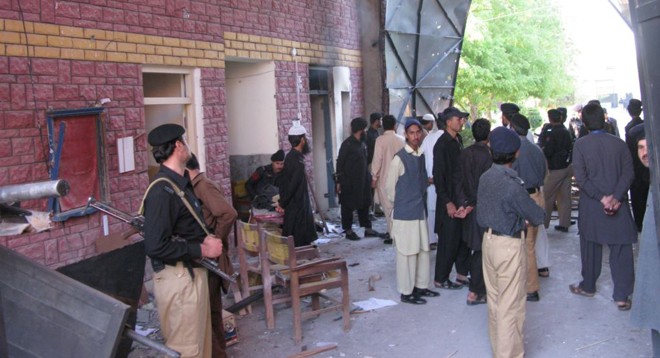

Currently, in 104 prisons of Pakistan, we have about 76000 inmates against the authorised capacity of about 43000. Out of these inmates, more than 44000 are under-trials and less than 15000 are convicted prisoners whereas 6600 are prisoners on death row. Punjab is bearing the bulk of the burden.
In Pakistan, rate of conviction is less than 20 per cent whereas more than 80 per cent are languishing in jails as under-trial prisoners. This is one of the reasons of overcrowding in our jails. Prosecution is new to the Punjab province while Prison as an institution is used as dumping grounds of all social and criminal refuse. Probation/Parole Department, on the other hand, is facing tremendous financial constraints.
For the past 15 years, none of the terrorists have been executed by our judicial system. It may be due to poor evidence mechanism, but the writ of the government is being seriously threatened repeatedly. Terrorists have their own philosophies and aggressive designs. All important laws of the Penal and Criminal Procedure Codes have been enforced throughout the country after legislation, but the law is still silent on the definition of ‘terrorist’ in this part of the world.
Those cases, the cognizance of which has been taken by the Anti-Terrorist Court, are treated under the definition of terrorism and those involved are ultimately landed into Pakistani prisons. These prisons are too vulnerable and insecure to accommodate them. Police are trying very hard to capture all those involved in terrorist activities but because of lack of evidence, they got released in the due process of law.
Militants and prison security:
Attacks on Bannu Jail and Dera Ismail Khan Jail have sufficient description to understand what can happen to these institutions from outside. Placement of radical elements in these prisons is itself a great challenge. We are controlling 104 prisons having 76000 prisoners with almost 18000 staff members, which is less than the police of any district in Punjab. The ratio of staff and inmate never worked out to be 1:4 but remained at 1:7 or at the most 1:6 which can’t be recommended for a better security arrangement for prisons. The revival of old Convict Officer and Convict Night Watchman Systems may be seriously considered once again to fill the gap under exceptional circumstances.
Prisoners shall never be allowed to keep cash and cell phones as it is seriously felt that criminals have strong network inside to control and carry out terrorist activities. Countries facing such kind of threats must appoint Prison or Correctional Advisors at the national level to guide, monitor and evaluate the prison functioning but we never think of such expertise to improve the prison management. In this context, we have to analyse the current situation of prison departments of all the provinces.
High security prisons:
At present, there are no high security prisons in Pakistan. However, in KP, six prisons are planned to be developed as high security prisons in D.I Khan, Bannu, Kohat, Dir (lower), Mansehra and Haripur. High security prisons should also be built in Swat.
In thickly-populated province of Punjab, two high security prisons at Mianwali and Sahiwal are likely to be built. Similarly, high security barracks at central jails Multan, Faisalabad, Lahore and Rawalpindi have also been earmarked for confinement of convicts involved in sabotage and terrorism.
In Sindh province, four central prisons -- Hyderabad, Karachi, Larkana and Sukkur-1, house up to 500 high profile extremists. New jails at Ghotki, Naushero Feroze, Mirpur Khas, Badin and Thatha will be made functional soon.
Balochistan has a very few extremists in jails. Out of 10 jails, only four jails -- Quetta, Mach, Khuzdar and ATF -- are used for confinement of such people there.
Security gadgets:
Although most of the prisons in Pakistan have adequate security arrangements, special security machinery and equipment are still required like X-ray scanning machine, CCTV system, hand-held metal detectors, wireless sets based stations, walkthrough gates, hand-held sets of walky talky, biometric system (finger identification on main entries), multi-channel digital voice logger, finger prints scanner, electronic doors and armed personnel carrier in at least those prisons where these terrorists are confined.
Trained staff:
Staff deployed on separate enclosures for extremists within prisons is often amongst the usual routine staff. In maximum security prisons, such extremists are looked after by the same prison staff and no specially trained staff is available to supervise the activities inside the area exclusively allotted for such type of prisoners. Their training must be based on psycho-social and legal aspects and stress/anger management be made a part of syllabus of such training courses.
Outside connections:
Mobile phone is a prohibited item for use by prisoners inside the prisons. It is a dangerous device to communicate with fellow prisoners and the outside world. Mobile phones are often misused by inmates for criminal activities. The head of criminal groups, terrorists and drug traffickers direct their accomplices sitting inside jail by using mobile phones. Misuse of mobile phone has also made safety and security of jail staff vulnerable.
Education system in prisons:
There is no organised education system in prisons. Prisoners usually get Graduate and Master level education through fellow educated prisoners who have already received qualification from local universities. Majority of the prisoners are illiterate but a very fine incentive of remission system encourages them to go for education. However, no trained or qualified teacher is on the strength of prison establishment to take care of their education.
There is dire need to rehabilitate extremists separately from other criminals. Terrorists need a different psycho-legal design of rehabilitation to change their internal socialisation process and shape their minds positively.
There is strong need to monitor corrupt practices inside the prisons through staff, neutral ex-officio visitors, philanthropists and members of civil society. Existing corrupt practices are another reason of aggression among prisoners.